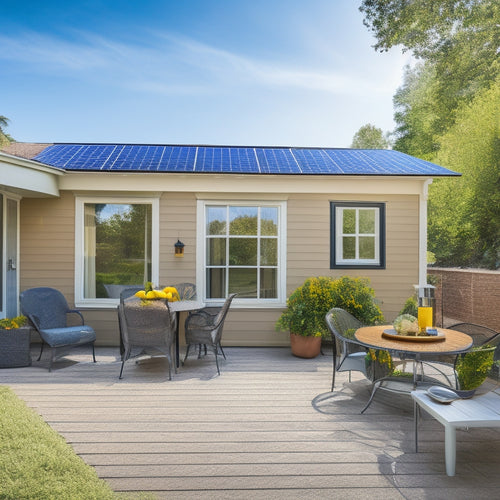
Mastering Solar Panel System Design in 3 Easy Steps
Share
You're about to reveal the secrets of designing a high-performing solar panel system that maximizes energy harvesting and reduces energy losses. First, you'll calculate your energy requirements to determine the system size and choose the right panels for your needs. Next, you'll select components that minimize energy losses and configure them for peak performance. Finally, you'll optimize the layout and configuration of your solar panel array to reduce shading and maximize energy yield. By mastering these essential steps, you'll be well on your way to designing a solar panel system that exceeds your expectations - and there's even more to explore.
Key Takeaways
• Calculate energy requirements to determine optimal system size and panel selection for maximum efficiency.
• Optimize panel orientation and configuration to minimize energy losses and maximize energy yield.
• Select high-efficiency components, including solar panels and inverters, to minimize energy waste and maximize power output.
• Conduct a shading analysis to identify and address obstructions that can significantly impact system performance.
• Ensure component compatibility and configure each component for optimal efficiency to achieve peak system performance.
Understanding Solar Panel Design Basics
When designing a solar panel system, calculating your energy requirements is essential, as it sets the foundation for a successful and efficient installation. You need to determine how much energy you want to generate, which will influence the size and type of solar panels you'll need.
To achieve peak performance, you'll also need to take into account panel orientation. The ideal orientation varies by location, but generally, a south-facing angle of 30-40 degrees is preferred. This orientation allows for maximum energy absorption during peak sun hours.
However, even with ideal orientation, energy losses are inevitable. You'll encounter losses due to temperature, wiring, and inverter inefficiencies. To minimize these losses, it's important to select high-quality components and design your system to reduce energy waste.
Designing Efficient Solar Panel Systems
To design an efficient solar panel system, you'll need to carefully select and configure each component to minimize energy losses and maximize power output. This requires a deep understanding of energy harvesting and system optimization principles. By optimizing each component, you can guarantee that your system operates at peak efficiency, generating the maximum amount of power from the available sunlight.
When selecting components, consider the system's voltage, current, and power requirements. Choose high-efficiency solar panels with low temperature coefficients to minimize energy losses. Make sure that the inverter is compatible with the panel's output and can handle the system's maximum power point.
Additionally, select a charge controller that can handle the system's voltage and current requirements.
Advanced System Design Techniques
Your advanced system design begins with optimizing the layout and configuration of your solar panel array. This involves strategically placing panels to minimize shading, reduce electrical losses, and maximize energy yield.
This is important because even partial shading can have a notable impact on your system's performance. To achieve ideal energy harvesting, you'll need to conduct a thorough Shading Analysis to identify potential obstructions and adjust your design accordingly.
Frequently Asked Questions
Can I Mix and Match Different Solar Panel Brands and Models?
'Just like a chef combining ingredients, you can mix and match solar panels, but be mindful: warranty comparison and panel compatibility are essential. Guarantee a seamless blend by checking manufacturers' specifications and certifications.'
How Often Should I Clean My Solar Panels to Maintain Efficiency?
You should clean your solar panels every 6-12 months to maintain efficiency, as dust accumulation reduces energy output; however, if you live in an area with frequent rainy days, cleaning may not be necessary as often.
Do Solar Panels Work During a Power Outage or Blackout?
"What a coincidence that you're wondering if solar panels work during a power outage! Unfortunately, they won't provide electricity during a blackout unless you have a grid backup system or emergency power setup, which you'll need to invest in separately."
Can I Install Solar Panels on a Metal or Asphalt Roof?
You can install solar panels on a metal or asphalt roof, but make sure the roof's durability and weather resistance can support the added weight and potential water intrusion, consulting a professional for a thorough assessment.
Will Solar Panels Increase My Property Value and Selling Price?
You'll be pleased to know that solar panels can increase your property value and selling price, thanks to appraisal benefits and alignment with neighborhood trends, which can boost your home's desirability and resale value.
Related Posts
-

Essential Accessories for Heavy Riders of E-Bikes
As a heavy rider of an e-bike, you need specialized gear that caters to your unique needs. Start with safety essentia...
-

10 Tips to Buy Affordable Solar Panels Online
When purchasing affordable solar panels online, you'll want to research reputable retailers, compare prices, and chec...
-

Top 7 Portable Solar Car Battery Solutions Online
You're in luck with our selection of reliable portable solar car battery solutions that meet your needs and budget. O...


